The United States National Park Service (NPS) has invited visitors to explore the country’s majestic mountains, rolling plains and colorful deserts for over a century. But never have so many people wanted to take advantage of the limitless adventures available within public lands.
Over the past decade, the number of National Park visitors has increased by more than 20 percent. In 2017 alone, more than 330 million people visited sites managed by NPS. And who can blame them: With 60 sites under National Parks designation, outdoor enthusiasts have a wide variety of stunning landscapes to choose from when selecting their next trip.
We’ve gathered all you need to know to plan your own adventure to one of the country’s 12 most popular national parks, as determined by visitor data. So get planning — nature at its most thrilling awaits. (And be prepared: America’s most popular park, and the staggering number of visitors it welcomes, may just surprise you.)
Bryce Canyon National Park
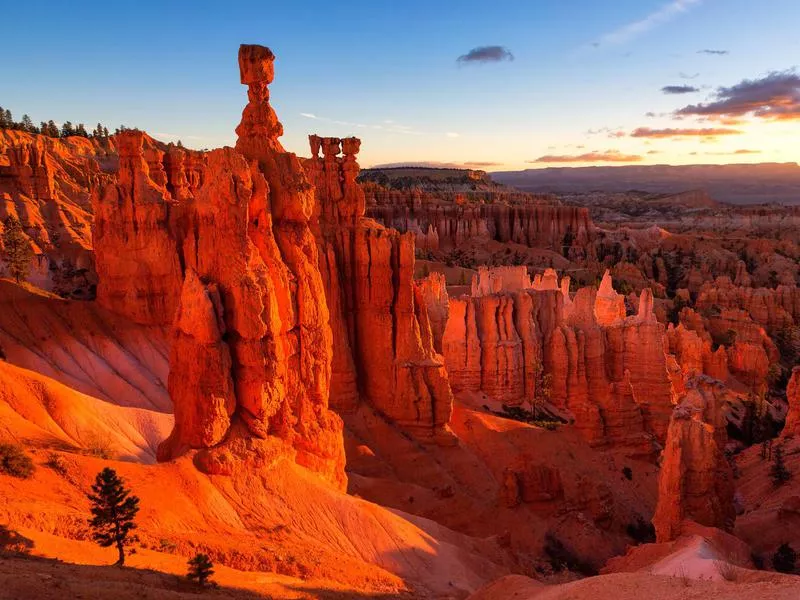
Thor’s Hammer is one of many breathtaking rock formations in Bryce Canyon. Bill_Vorasate / Getty Images
Home to the largest collection of hoodoos — pillars of rock formed by decades of erosion — in the world, Utah’s Bryce Canyon National Park is a true wonder to behold. Each year, these incredible rock formations attract roughly 2.5 million visitors, making the park the nation’s 12th most popular.
Go during the spring to see the stark rust-red landscapes dotted with an assortment of colorful wildflowers. Feeling somewhat adventurous? Embark on a moderate hike on the Navajo Loop Trail, which begins at Sunset Point. This 1.3-mile loop trail is one of the park’s most popular paths, leading visitors down to Bryce Amphitheater through a slot canyon where you can experience hoodoos up close.
Where to Eat
After a day of calorie-burning exploration, enjoy hearty home cooking at Bryce Canyon Pines Restaurant. This cozy local favorite has been serving generous portions of satisfying classics (think T-bone steak, fish and chips, and cheeseburgers) for more than 50 years.
Where to Stay
Embrace the rugged atmosphere of the canyons with a stay at Bryce Canyon Lodge. Built in 1924, this historic lodge melds scenic views with close proximity to many of the park’s trails. With a variety of room options and an onsite restaurant, the lodge offers visitors a comfortable oasis within the wilderness.
Joshua Tree National Park
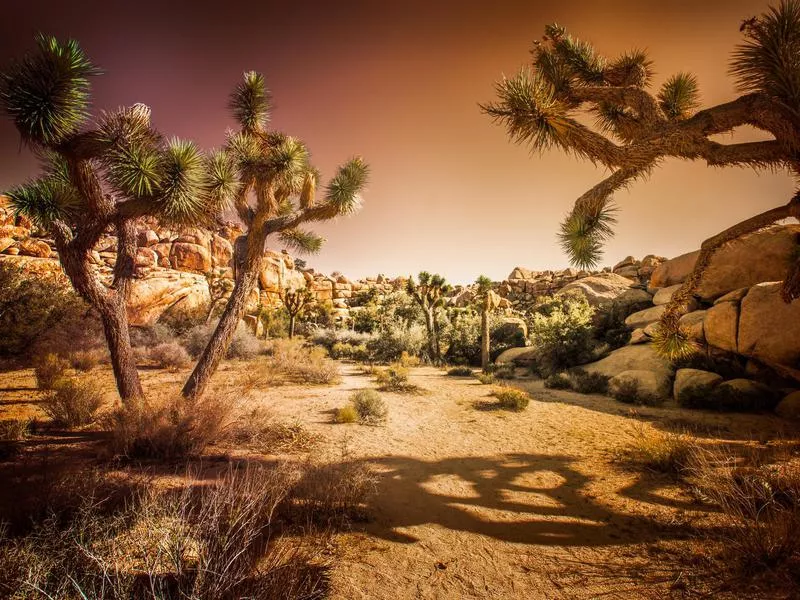
Joshua Tree National Park gets its name from the distinctive desert trees blanketing its terrain. Steven_Kriemadis / Getty Images
In Joshua Tree National Park, the distinct Mojave and Colorado deserts merge to form a park favored among hikers and climbers. The park’s eponymous, twisting joshua trees are a striking sight, no two of which are alike. This unique landscape attracts approximately 2.8 million visitors each year.
Hikers of all skill levels will enjoy the one-mile round trip nature walk to Arch Rock. Another popular destination, Skull Rock, is accessible by car or via a 1.7-mile nature trail that begins at Jumbo Rocks Campground.
Where to Eat
Stop by Joshua Tree Saloon just outside the park for hefty burgers, cold beer and live music. Or head down the road to Crossroads Cafe for a quirky diner vibe and wholesome Southwestern favorites.
Where to Stay
While there is no formal lodging within Joshua Tree, the park does offer nine campgrounds. Visitors can also get a feel for Hollywood’s Old West by booking a stay at the nearby Pioneertown Motel. Located in Yucca Valley, Calif., this motel was built in 1946 by actor Roy Rogers as lodging for early Western movie stars. It’s recently been fully renovated to offer the best of desert comfort.
Glacier National Park

Wild Goose Island sits on Glacier’s placid Saint Mary Lake. HaizhanZheng / Getty Images
Known as the “Crown of the Continent,” Glacier National Park supplies water for streams that flow as far as the Pacific Ocean, Gulf of Mexico and Canada’s Hudson’s Bay. In addition to serving an essential role in the ecosystem, Glacier wows 3.3 million visitors annually through sheer scale: It spans more than 1 million acres and straddles two countries (the U.S. and Canada).
Experience the majesty of the park by driving Going-to-the-Sun Road. Only open during the summer season, it spans 50 miles and takes two hours to drive without stopping. Along the way, stop by Logan Pass, the highest elevation in the park that’s reachable by car.
Where to Eat
Embrace a local favorite with a meal at Two Sisters Cafe near Babb, Montana. In the summertime, this colorful eatery — complete with an “Aliens Welcome” sign on the roof — serves lunch, dinner and, most importantly, huckleberry pie.
Where to Stay
Tiny Home Village at St. Mary Village, a new collection of eco-friendly homes, gives visitors a glimpse of cozy-yet-chic tiny home living.
Grand Teton National Park

Bison roam the wide-open spaces of Grand Teton National Park. moose henderson / Getty Images
Serene alpine lakes, wild forests and awe-inspiring vistas of staggering peaks draw some 3.3 million visitors annually to Wyoming’s Grand Teton National Park. Located just an hour or so south of Yellowstone, Grand Teton offers boating, birdwatching, mountaineering and more. Watch out for native bison, which have survived since prehistoric times.
When visiting the park, the towering Grand Teton is never far from view. The 13,770-foot peak of the Teton Mountain range is a particularly popular destination for experienced climbers and long-distance hikers. If summiting the mountain isn’t on your itinerary, consider driving Teton Park Road, a 42-mile loop, to experience all this scenic park has to offer.
Where to Eat
Start your day with a rustic breakfast at Chuckwagon at Dornans in Jackson Hole, Wyo. This authentic Old West dining experience has been a favorite among both visitors and locals since 1947. During the warm summer months, enjoy a meal there al fresco.
Where to Stay
Located across from Jenny and Sting Lakes, Jenny Lake Lodge is a luxurious option. The property was originally a dude ranch, but it has since been renovated into an elegant, relaxing retreat with striking views of the Grand Teton Cathedral group.
Olympic National Park

Ruby Beach is in the coastal section of Olympic National Park. tonda / Getty Images
Olympic National Park spans nearly a million miles of incredibly diverse landscape. With miles of rugged coastline, deeply wooded rainforests and snow-capped mountains, it has something for every one of its 3.4 million annual visitors.
Don’t forget to visit the park’s vibrant tidepools, teeming with colorful starfish, urchins and crabs. Some of the most popular pools can be found at Mora’s Hole in the Wall, about 1.5 miles north of the Rialto Beach Trailhead. During low tide, this area is the perfect place to discover coastal wildlife.
Where to Eat
Located in nearby Sequim, Wash., Blondie’s Plate offers small plates of locally sourced fare. This cozy restaurant highlights the Pacific Northwest’s contemporary food scene and mixes some of the best handcrafted cocktails you’ll find in the region.
Where to Stay
Step back in time with a stay at Lake Crescent Lodge within the boundaries of the park, perched on the shore of Lake Crescent, this turn-of-the-century lodge offers a variety of rooms and cabins deep within the forest.
Acadia National Park

Bass Harbor Lighthouse is a quintessentially Maine touch in Acadia National Park. Philippe Gratton / Getty Images
Maine’s Acadia National Park is a jewel of America’s Atlantic coast. With seven peaks reaching above 1,000 feet, 150 miles of hiking trails and 16 stone bridges, its natural beauty impresses more than 3.5 million visitors each year. Watch out for moose, coyotes, otters and black bears.
And make sure to explore Cadillac Mountain, which is not only the tallest peak in the park at 1,530 feet, but also the highest mountain along the country’s East Coast. This natural wonder is accessible by car via a narrow, winding road that closes for the winter months. Continue your drive with a ride along the 27-mile Park Loop Road to experience views of the ocean shoreline.
Where to Eat
The Jordan Pond House Restaurant has been serving tea and popovers since the 1890s. This Mount Desert Island staple is open seasonally and still serves traditional high tea on the front lawn. Or opt to leave the park to visit Burning Tree Restaurant. Also open seasonally, this farm-to-table eatery serves fresh seafood and veggies plucked from onsite gardens.
Where to Stay
While there are no indoor lodging options within the park, Acadia does offer two rustic campgrounds. Outside of the park, charming coastal inns and B&Bs are plentiful on the island. Accommodations like Bass Cottage Inn in nearby Bar Harbor offer ample charm without skimping on luxury.
Yellowstone National Park
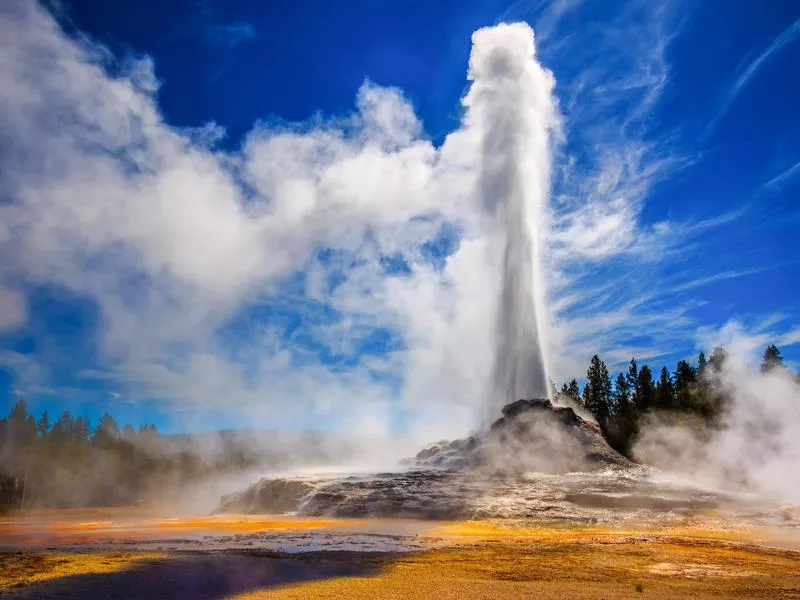
Castle Geyser dramatically erupts in Yellowstone National Park. Riishede / Getty Images
Established in 1872, Yellowstone was the country’s first national park. It spans three states (Wyoming mostly, plus Montana and Idaho) and welcomes more than 4.1 million visitors each year. Sightseers come for its famous geysers and equally well-known creatures, from badgers and bobcats to lynxes and wolverines.
Have limited time to explore? If you’re only going to see one thing at Yellowstone, it should probably be Old Faithful. The iconic geyser is actually one of nearly 500 in the park, but unlike most of the others, it’s still erupting. (True to its name, it’s gone off every 44 to 125 minutes since 2000.) Join in the tradition by camping out to watch this impressive natural event, and to learn about how it and other geological marvels formed millions of years ago.
Where to Eat
Head west out of the park to enjoy dinner at Madison Crossing Lounge in West Yellowstone, Mont. Housed in a historic 1918 schoolhouse, the eatery serves craft brews, inventive cocktails and a mean cut of flat-iron steak.
Where to Stay
Within the park, Yellowstone has nine lodges with more than 2,000 rooms available. But if crowds and indoor plumbing aren’t what you’re after, backcountry camping is also an option at one of more than 300 sites. Before you head out onto the hundreds of miles of mountainous terrain, remember that permits are required for all overnight stays.
Yosemite National Park
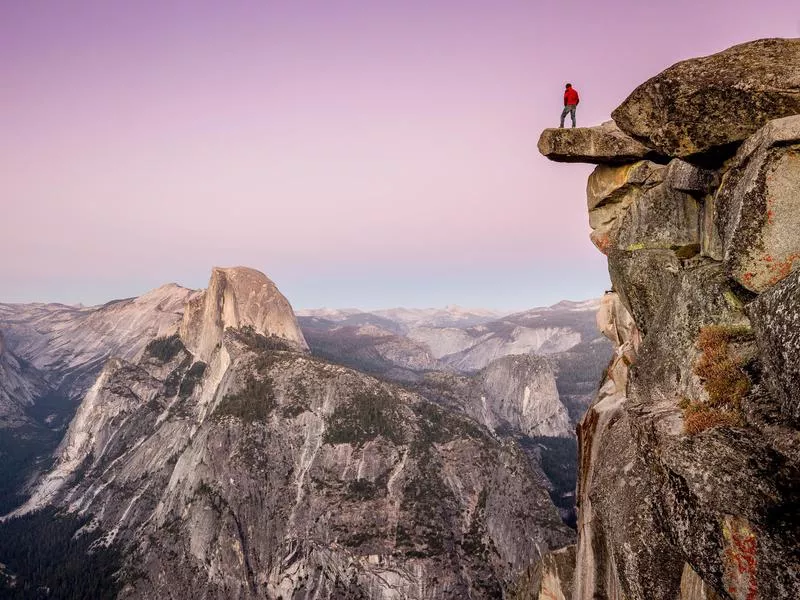
A hiker reaches new heights in Yosemite National Park. bluejayphoto / Getty Images
More than 95 percent of California’s Yosemite National Park is considered wilderness, poetically defined by NPS as “an area where the earth and its community of life are untrammeled by man, where man himself is a visitor who does not remain.” Some 4.3 million annual visitors come from far and wide to explore the park’s diverse natural features, including rugged rock formations, massive Sequoias and an outstanding collection of waterfalls — three of which are among the world’s 20 tallest.
One of Yosemite’s most iconic sites is Glacier Point, which offers breathtaking views of the floor of Yosemite Valley and Half Dome, a granite rock formation rising up 5,000 feet. This comprehensive lookout is accessible by road, so visitors can avoid a strenuous climb up to one of the park’s highest peaks.
Where to Eat
If you’re looking for an elegant meal, head to the aptly named, award-winning Majestic Yosemite Dining Room. It pairs sublime cuisine with 34-foot ceilings, expansive windows and copious chandeliers.
Where to Stay
Enjoy an authentic Yosemite experience with a stay at Evergreen Lodge. Opened in the 1920s, this historic complex is comprised of 88 fully furnished cabins nestled beneath the park’s towering pine trees.
Rocky Mountain National Park
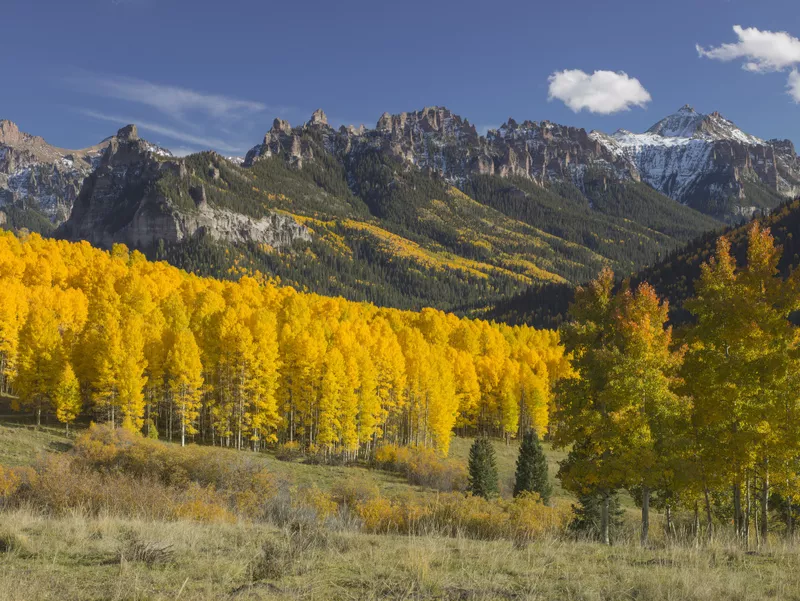
Fall is a particularly spectacular time to explore Rocky Mountain National Park. antonyspencer / Getty Images
Rocky Mountain National Park has been welcoming record numbers of visitors — more than 4.4 million last year — and it’s easy to see why. With more than 300 miles of hiking trails and abundant wildlife, this sprawling alpine tundra is begging to be explored.
For visitors looking for a moderate hike with breathtaking vistas, Emerald Lake Trail is a popular way to experience the park. Departing from the Bear Lake trailhead, the 1.8-mile trail leads past Nymph Lake and Dream Lake to Emerald Lake, with an incredible view of Hallett Peak in the distance. Trail Ridge Road is the highest paved road in the United States and a popular choice for visitors seeking a scenic drive. The ridge crests at roughly 12,000 feet and crosses the Continental Divide at Milner Pass.
Where to Eat
Take a step back in time with a visit to the dining room at Baldplate Inn. It dates back more than a century and continues to serve a classic soup and salad buffet overlooking the mountain valley.
Where to Stay
If camping and rustic cabins aren’t what you have in mind for your adventure, add a touch of the paranormal to your trip with a stay at the infamous Stanley Hotel. While it’s mostly known for its spookiness — it inspired Stephen King’s The Shining — it’s also a historic beauty that will serve as the perfect homebase during your time in Estes Park.
Zion National Park
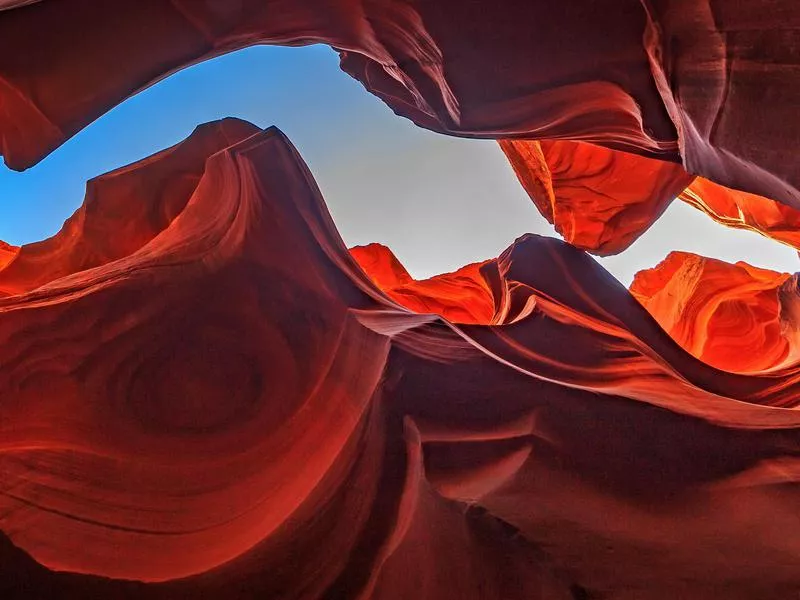
Marvelous sandstone canyons distinguish Zion National Park. johnnya123 / Getty Images
Utah’s first national park is home to geologic layers tracing back 150 million years. Explore Zion by hiking, biking or climbing, and discover the sandstone cliffs, slot canyons and forking rivers that helped earn it the nickname “the heavenly city.” In 2017 alone, more than 4.5 million visitors explored this unique landscape.
One of Zion’s most popular hikes is The Narrows, which travels along the narrowest part of Zion Canyon. While hikers wanting to explore the impressive landscape must hike through the Virgin River, one mile of the The Narrows is also visible from a wheelchair-accessible riverwalk near the Temple of Sinawava. Most hikers opt to explore The Narrows in late spring and summer, when the water is warmer and river levels are lower. Angel’s Landing, at nearly 1,500 feet tall, is another popular choice, luring hikers who aren’t afraid of heights.
Where to Eat
Venture outside of the park to grab a meal at The Bit and Spur Restaurant and Saloon. This Springdale, Utah, eatery delivers contemporary Mexican and Southwestern fare in a rustic setting that perfectly complements a day in the desert.
Where to Stay
In addition to the park’s three campgrounds, Zion Lodge is open year-round and offers visitors a choice of cabins, hotel rooms and suites. Those looking to connect with nature without sacrificing luxury may want to consider Under Canvas, which does glamping right by offering desert-set platform tents with ensuite bathrooms, viewing windows and private decks.
Grand Canyon National Park
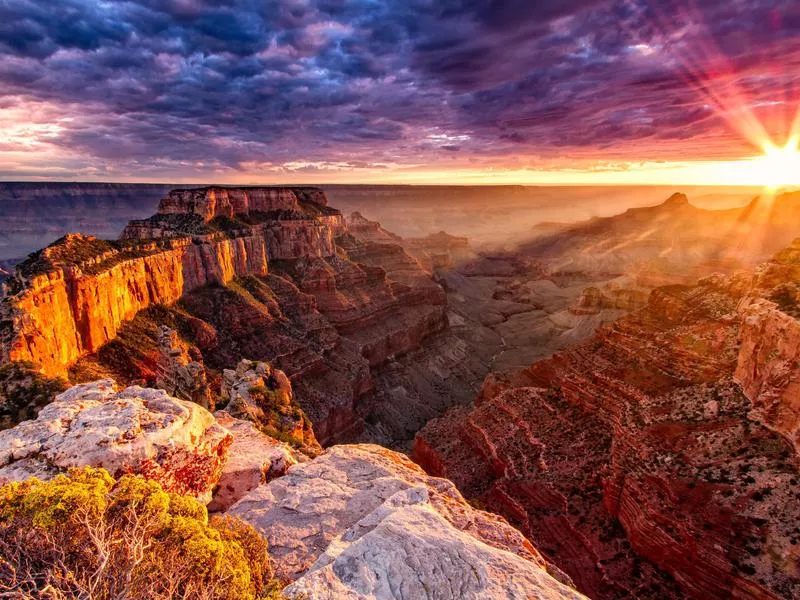
The North Rim of the Grand Canyon dazzles (so does the South Rim). erikharrison / Getty Images
It’s no shock that the Grand Canyon is still one of America’s most-visited national parks, welcoming more than 6.2 million visitors in 2017. A mile deep, up to 18 miles wide and 277 river miles long, its sheer scope truly is grand.
When visiting the park, you’ll first need to decide if you want to visit the North or South Rim. While the South Rim is open year-round, the North Rim closes between October 15 and May 15 each year. Explore the South Rim by hopping on a free shuttle bus along the scenic 7-mile Hermit Road, or hike the Canyon Rim Trail, which follows the canyon along the roadway for 7.8 miles.
Where to Eat
Visitors may be surprised to discover the variety of dining options available within the park. In the South Rim, enjoy a meal in the dining room of the historic, circa-1903 El Tovar Hotel. This internationally recognized restaurant serves Southwestern fare and has hosted notable guests like Teddy Roosevelt, Bill Clinton and Sir Paul McCartney.
Where to Stay
While options are abundant around the park, visitors looking for a true Grand Canyon experience need to look no further than Phantom Ranch. The only lodging located below the canyon rim features stone cabins dating back to 1922. The only way to reach Phantom Ranch is on mule, by foot or by rafting down the Colorado River. Space in these remote cabins is extremely limited — a reservation lottery is held 15 months in advance — so you’ll need to plan well in advance.
Great Smoky Mountains National Park
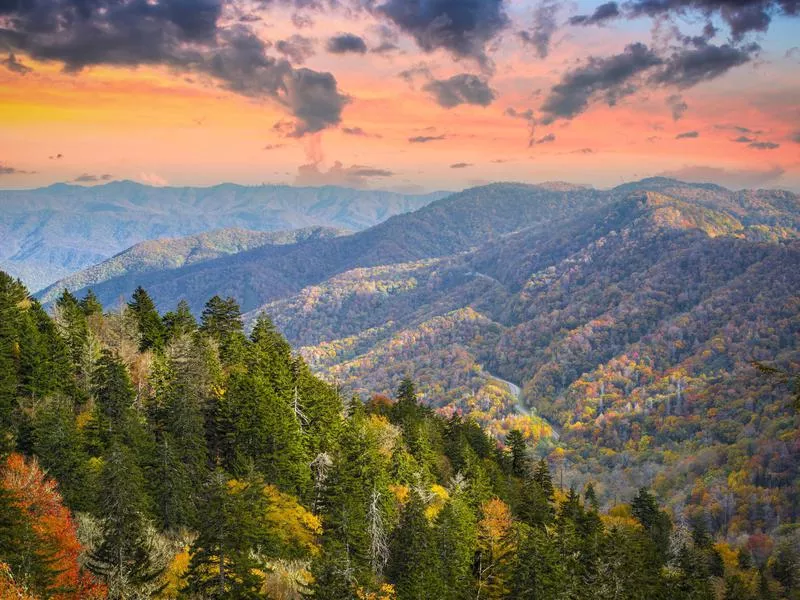
America’s most popular national park holds the honor for a reason. SeanPavonePhoto / Getty Images
Some may be surprised to learn that Great Smoky Mountains National Park welcomed more visitors than any other by far last year — a staggering 11.3 million, nearly twice as many as the Grand Canyon. But considering its incomparable combination of wooded tranquility and mountain splendor, the park’s popularity makes a lot of sense. Straddling the border between North Carolina and Tennessee, the park boasts one of America’s oldest mountain ranges and includes a portion of the famous Appalachian Trail.
One of the park’s most popular destinations is Cades Cove, a valley within the mountains where Cherokee Indians once hunted and European settlers made their homes. Hikers not easily scared off by a steep climb can step out onto the Appalachian Trail to experience breathtaking views from a stone outcropping known as Charlies Bunion. This four-mile hike culminates with a panoramic vista from an elevation of 6,000 feet; it will make you feel as if you’re walking along the peak of the Smoky Mountains.
Where to Eat
When it comes to dining, options are limited within the park, with snacks and limited groceries available at Cades Cove Campground Store. But just outside the park’s entrance in Gatlinburg, Tenn., you’ll find plenty of options — including The Park Grill, promising a “true taste of the Smokies” through its expansive menu of Southern Appalachian favorites.
Where to Stay
While a variety of campsites are available, the only cabin lodging within the park is LeConte Lodge. Located at the crest of Mount LeConte, the park’s third highest peak, it’s accessible only by foot, via hiking routes that vary from five to eight miles. If you want to enjoy spectacular views of the Smokies from your doorstep, this is the place to stay.